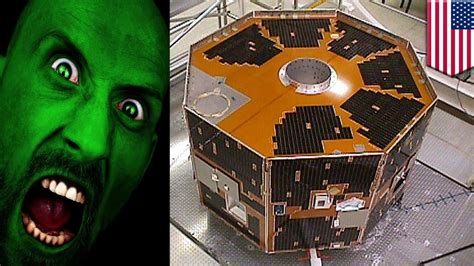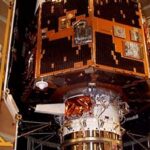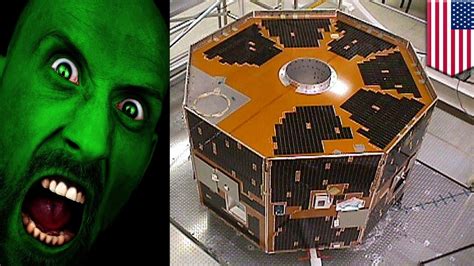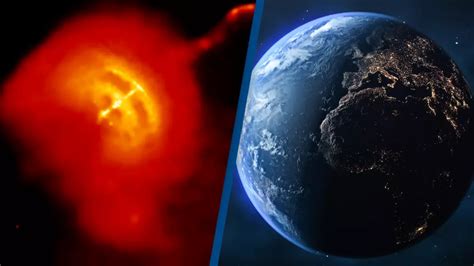
A defunct NASA satellite, the Reuven Ramaty High Energy Solar Spectroscopic Imager (RHESSI), unexpectedly re-entered Earth’s atmosphere on Wednesday night, leading to heightened but ultimately unfounded concerns about potential debris impact.
The 660-pound satellite, launched in 2002 to study solar flares and decommissioned in 2018, plunged back to Earth at approximately 8:30 p.m. EDT, according to NASA officials. While the vast majority of the spacecraft was expected to burn up during its fiery descent, the possibility of surviving fragments reaching the surface prompted careful monitoring.
“NASA and the Department of Defense closely monitored RHESSI’s re-entry,” the agency stated in an official update. The primary concern centered on the potential, albeit small, risk of debris causing damage or injury.
The uncontrolled re-entry of RHESSI highlights the growing challenge of space debris management and the complexities involved in mitigating the risks posed by defunct satellites. While no injuries or significant damage were reported in this instance, the event serves as a reminder of the increasing need for proactive measures to address the problem of space junk orbiting our planet.
The RHESSI Mission and its Objectives
Launched on February 5, 2002, RHESSI, named after the pioneering solar physicist Reuven Ramaty, was a dedicated solar observatory designed to study the physics of solar flares and coronal mass ejections (CMEs). Solar flares are sudden releases of energy from the Sun’s surface, often associated with sunspots and active regions. These flares can release tremendous amounts of energy in the form of X-rays, gamma rays, and charged particles, impacting space weather and potentially disrupting communications and power grids on Earth.
RHESSI’s primary mission was to image solar flares in high-energy X-rays and gamma rays. This allowed scientists to study the acceleration of electrons and ions during flares, providing insights into the mechanisms that drive these explosive events. Unlike many other solar observatories that focus on visible light or ultraviolet radiation, RHESSI offered a unique view of the Sun’s high-energy emissions, complementing other missions and contributing to a more comprehensive understanding of solar activity.
The satellite carried a single instrument: an imaging spectrometer comprised of nine germanium detectors. This instrument was designed to measure the energy and intensity of X-rays and gamma rays emitted by solar flares with unprecedented spectral resolution and imaging capabilities. By analyzing the energy spectra of these emissions, scientists could determine the temperature, density, and composition of the plasma within the flares, as well as the energy distribution of the accelerated particles.
RHESSI’s observations led to numerous important discoveries about solar flares, including:
- The discovery of evidence for electron acceleration in the corona: RHESSI provided direct evidence that electrons are accelerated to high energies in the Sun’s corona, the outermost layer of the Sun’s atmosphere. This challenged previous theories that suggested acceleration only occurred in the lower atmosphere.
- The mapping of flare locations: RHESSI’s imaging capabilities allowed scientists to pinpoint the locations where high-energy particles are produced during flares. This helped to understand the magnetic field structures and reconnection processes that drive flare activity.
- The determination of the energy distribution of flare particles: RHESSI’s spectral measurements enabled scientists to determine the energy distribution of electrons and ions accelerated during flares. This information is crucial for understanding the efficiency of particle acceleration mechanisms.
- The study of the relationship between flares and CMEs: RHESSI observations helped to elucidate the relationship between solar flares and coronal mass ejections, two of the most energetic phenomena in the solar system.
RHESSI operated successfully for over 16 years, far exceeding its original two-year design life. Throughout its mission, it collected a wealth of data that has been used by scientists around the world to study solar flares and their impact on the Earth’s environment.
Decommissioning and Re-entry Predictions
NASA decommissioned RHESSI in 2018 due to communication issues. While still scientifically valuable, the satellite’s ability to transmit data reliably was compromised, rendering it no longer operational. Following decommissioning, RHESSI was left in its low Earth orbit, gradually losing altitude due to atmospheric drag.
Predicting the precise timing and location of a satellite’s re-entry is a complex task, influenced by numerous factors including atmospheric density, solar activity, and the satellite’s shape and orientation. NASA and the Department of Defense Space Surveillance Network continuously track thousands of objects in orbit, including defunct satellites like RHESSI, to provide re-entry predictions.
These predictions are based on sophisticated models that take into account the forces acting on the satellite as it interacts with the Earth’s atmosphere. However, these models are not perfect, and the actual re-entry time and location can vary by several hours or even days from the initial predictions. This uncertainty is due to the inherent variability of the Earth’s atmosphere, which is affected by solar activity and other factors that are difficult to predict precisely.
In the case of RHESSI, NASA provided regular updates on the satellite’s re-entry trajectory, refining their predictions as the satellite approached Earth. These updates were based on the latest tracking data and atmospheric models. NASA officials emphasized that the risk of debris causing harm was low, but they also acknowledged the inherent uncertainties involved in re-entry predictions.
The Risks of Uncontrolled Re-entry
The uncontrolled re-entry of satellites like RHESSI poses a risk to people and property on the ground, although the probability of actual damage or injury is generally low. Most of a satellite is designed to burn up during re-entry, but some components, particularly those made of heat-resistant materials like titanium or stainless steel, may survive the intense heat and reach the surface.
The size and mass of the surviving debris determine the potential for damage. Larger fragments can cause significant damage to buildings or vehicles, while smaller fragments may pose a risk of injury to people. The risk is highest in densely populated areas, but the vast majority of the Earth’s surface is covered by water or sparsely populated land.
The international space community has established guidelines for mitigating the risks of re-entry. These guidelines recommend designing satellites to minimize the amount of debris that survives re-entry and to control the re-entry process as much as possible. Controlled re-entry involves using a satellite’s propulsion system to guide it towards a remote area of the ocean, minimizing the risk of debris impacting populated areas.
However, not all satellites are equipped with propulsion systems capable of performing controlled re-entry, and even those that are can experience malfunctions that prevent them from being guided safely. In these cases, uncontrolled re-entry is the only option.
The re-entry of RHESSI highlights the growing concern about space debris and the need for more effective measures to mitigate the risks it poses. As the number of satellites in orbit continues to increase, the problem of space debris will only become more pressing.
Space Debris: A Growing Problem
Space debris, also known as space junk or orbital debris, refers to any non-functional, human-made object in orbit around the Earth. This includes defunct satellites, spent rocket stages, fragments from collisions and explosions, and even small items like tools dropped by astronauts.
The amount of space debris in orbit has been steadily increasing since the beginning of the space age. Decades of space activities have left a legacy of millions of pieces of debris, ranging in size from tiny paint flecks to large, intact spacecraft.
Space debris poses a significant threat to operational satellites and spacecraft. Even small pieces of debris can cause serious damage upon impact, due to the high speeds at which objects travel in orbit. Collisions with debris can damage or destroy satellites, disrupt communications, and create even more debris in a cascading effect known as the Kessler Syndrome.
The Kessler Syndrome, named after NASA scientist Donald Kessler, is a scenario in which the density of objects in low Earth orbit (LEO) is high enough that collisions between objects could cause a cascade, where each collision generates space debris that increases the likelihood of further collisions. This could eventually make certain orbital ranges unusable for future generations.
The accumulation of space debris also poses a risk to astronauts on spacewalks and to the International Space Station (ISS). The ISS is equipped with shielding to protect it from small debris, but larger pieces of debris can still pose a threat.
Mitigation and Remediation Efforts
The international space community recognizes the growing threat of space debris and has been working to develop strategies to mitigate its growth and remediate the existing debris population.
Mitigation strategies focus on preventing the creation of new debris. These strategies include:
- Designing satellites to minimize the generation of debris: This includes using materials that are less likely to fragment during launch or operation, and designing spacecraft to be easily deorbited at the end of their mission.
- Avoiding intentional breakups of satellites: This includes disabling batteries and venting propellant tanks to prevent explosions after a satellite has reached the end of its life.
- Improving tracking and monitoring of space debris: This allows operators to avoid collisions with known debris objects.
- Developing technologies for active debris removal: This includes technologies for capturing and removing existing debris from orbit.
Remediation strategies focus on removing existing debris from orbit. This is a more challenging and expensive undertaking than mitigation, but it is considered necessary to reduce the overall risk posed by space debris.
Several technologies are being developed for active debris removal, including:
- Robotic arms: These can be used to grapple and deorbit large debris objects.
- Nets and harpoons: These can be used to capture smaller debris objects.
- Lasers: These can be used to vaporize small debris objects or to nudge larger objects into lower orbits where they will burn up in the atmosphere.
- Aerogel: Aerogel can be used to capture debris upon impact due to its high absorption capability.
The development of effective and affordable debris removal technologies is a major challenge, but it is essential for ensuring the long-term sustainability of space activities.
The Future of Space Debris Management
The uncontrolled re-entry of RHESSI underscores the need for continued efforts to address the problem of space debris. As the space environment becomes increasingly congested, the risks posed by space debris will only grow.
The international space community must work together to develop and implement effective strategies for mitigating the growth of space debris and remediating the existing debris population. This will require a combination of technological innovation, policy changes, and international cooperation.
In addition to developing new technologies for debris removal, it is also important to improve the accuracy of space debris tracking and prediction models. This will allow operators to better avoid collisions with debris and to make more informed decisions about satellite design and operations.
Furthermore, international regulations and guidelines for space debris mitigation need to be strengthened and enforced. This will require a greater level of commitment from all spacefaring nations to responsible space activities.
The long-term sustainability of space activities depends on our ability to effectively manage the problem of space debris. By investing in research and development, implementing responsible space practices, and fostering international cooperation, we can ensure that future generations will be able to explore and utilize the benefits of space without being hindered by the legacy of past activities.
FAQ: RHESSI Satellite Re-entry
-
What was RHESSI and what was its purpose?
RHESSI, the Reuven Ramaty High Energy Solar Spectroscopic Imager, was a NASA satellite launched in 2002 to study solar flares and coronal mass ejections by imaging them in high-energy X-rays and gamma rays. It aimed to understand the acceleration of particles during these solar events.
-
Why did RHESSI re-enter the Earth’s atmosphere?
RHESSI was decommissioned in 2018 due to communication issues. Without active propulsion to maintain its orbit, it gradually lost altitude due to atmospheric drag, leading to its eventual re-entry.
-
Was the RHESSI re-entry dangerous?
While most of the satellite was expected to burn up during re-entry, there was a small risk of some fragments surviving and reaching the ground. NASA monitored the re-entry closely, and the risk of injury or significant damage was considered low. Ultimately, no damage or injuries were reported.
-
What is space debris, and why is it a concern?
Space debris consists of non-functional, human-made objects in orbit, including defunct satellites, rocket stages, and fragments from collisions. It poses a threat to operational satellites and spacecraft due to the high speeds at which objects travel in orbit, potentially causing damage or destruction.
-
What is being done to address the problem of space debris?
Efforts to address space debris include mitigation strategies such as designing satellites to minimize debris generation, avoiding intentional breakups, and improving tracking. Remediation strategies are also being developed, including technologies for active debris removal like robotic arms, nets, and lasers. International cooperation and stronger regulations are crucial for effective space debris management.
Extended Analysis: A Deeper Dive into Space Debris and its Implications
The RHESSI re-entry event, while ultimately benign in its outcome, serves as a crucial case study in the escalating challenge of space debris management. The sheer volume of inactive satellites, spent rocket stages, and fragmented debris orbiting Earth presents a multifaceted problem with scientific, economic, and geopolitical dimensions. To fully grasp the significance of this issue, we must delve into the intricacies of its formation, its impact on space activities, and the innovative solutions being explored to mitigate its effects.
The Genesis of Space Debris: A Historical Perspective
The problem of space debris is intrinsically linked to the history of space exploration. Every launch since Sputnik in 1957 has contributed to the ever-growing accumulation of objects orbiting our planet. Early space activities were conducted without a full appreciation of the long-term consequences of leaving behind spent rocket stages and defunct satellites. Over time, accidental explosions and collisions in orbit have further exacerbated the situation, creating a complex web of debris that threatens current and future space operations.
One of the most significant debris-generating events was the 2009 collision between the active Iridium 33 communications satellite and the defunct Russian Cosmos 2251 satellite. This collision created thousands of new pieces of debris, significantly increasing the risk of further collisions in low Earth orbit (LEO). Similarly, an anti-satellite missile test conducted by India in 2019 created a substantial amount of new debris, drawing international condemnation due to the potential impact on space sustainability.
The Economic Impact of Space Debris: A Costly Threat
The presence of space debris has profound economic implications for the space industry. Operational satellites require constant monitoring and maneuvering to avoid collisions with debris objects. These avoidance maneuvers consume fuel, shorten satellite lifespans, and increase operational costs. Insurance premiums for satellites are also rising due to the increased risk of damage or loss from debris collisions.
Beyond the direct costs associated with collision avoidance and insurance, space debris also poses a threat to the broader space economy. Disruption of satellite services, such as communications, navigation, and Earth observation, can have cascading effects on various sectors, including telecommunications, transportation, agriculture, and national security. A major collision event could cripple critical satellite infrastructure, leading to significant economic losses.
The development of debris removal technologies and space situational awareness systems also represents a significant economic opportunity. Companies are investing in innovative solutions to track, characterize, and remove space debris, creating new markets and driving technological innovation. However, the economic viability of these solutions remains a challenge, as the costs of debris removal can be substantial.
Geopolitical Considerations: A Shared Responsibility
Space debris is not just a technical or economic problem; it also has significant geopolitical implications. Access to space is becoming increasingly important for national security, economic competitiveness, and scientific advancement. The presence of space debris threatens the ability of all nations to safely and reliably access and utilize space.
Addressing the problem of space debris requires international cooperation and a shared commitment to responsible space activities. However, reaching consensus on debris mitigation and remediation measures can be challenging, given differing national interests and priorities. Some nations may be reluctant to adopt stricter regulations or invest in debris removal technologies if they perceive it as a competitive disadvantage.
The United Nations Committee on the Peaceful Uses of Outer Space (COPUOS) has developed a set of guidelines for space debris mitigation, but these guidelines are not legally binding and their implementation varies widely among nations. There is a growing call for a more comprehensive and legally enforceable international framework for space debris management.
Innovative Solutions: Charting a Path Forward
Despite the challenges, significant progress is being made in developing innovative solutions to mitigate and remediate space debris. These solutions can be broadly categorized into the following areas:
- Improved Space Situational Awareness (SSA): Accurate tracking and characterization of space debris are essential for collision avoidance and debris removal. SSA systems are being enhanced with advanced sensors, data processing techniques, and artificial intelligence to provide more comprehensive and timely information about the space environment.
- Passivation and Deorbiting Strategies: Designing satellites to be easily passivated (i.e., rendering them inert) at the end of their mission can prevent accidental explosions and reduce the risk of debris generation. Deorbiting strategies, such as using propulsion systems to lower satellites into the atmosphere for controlled re-entry, can remove defunct satellites from orbit before they become a hazard.
- Active Debris Removal (ADR) Technologies: A variety of ADR technologies are being developed to capture and remove existing debris from orbit. These include robotic arms, nets, harpoons, tethers, and drag sails. Each technology has its own strengths and limitations, and the optimal approach may vary depending on the size, shape, and orbit of the debris object.
- On-Orbit Servicing and Manufacturing: On-orbit servicing technologies, such as refueling, repair, and upgrade capabilities, can extend the lifespan of existing satellites and reduce the need for new launches. On-orbit manufacturing could potentially enable the construction of large space structures without the need for massive launch vehicles, further reducing the risk of debris generation.
The Need for a Holistic Approach
Addressing the problem of space debris requires a holistic approach that encompasses technological innovation, policy changes, international cooperation, and public awareness.
- Technological Innovation: Continued investment in research and development is essential for developing more effective and affordable debris mitigation and remediation technologies. This includes advances in SSA, ADR, on-orbit servicing, and sustainable spacecraft design.
- Policy Changes: Governments need to adopt and enforce stricter regulations for space debris mitigation, including requirements for passivation, deorbiting, and responsible spacecraft operations. These regulations should be aligned internationally to ensure a level playing field for all space actors.
- International Cooperation: Space debris is a global problem that requires a coordinated international response. Nations need to work together to share data, develop common standards, and support joint research and development efforts.
- Public Awareness: Raising public awareness about the importance of space sustainability can help to foster a sense of responsibility and encourage support for policies and initiatives that address the problem of space debris.
The RHESSI re-entry event serves as a timely reminder of the growing challenge of space debris. By taking proactive steps to mitigate and remediate space debris, we can ensure that future generations will be able to safely and sustainably access and utilize the benefits of space. The future of space exploration and utilization depends on our collective commitment to responsible space stewardship.


![Oreo’s [Flavor Name] So Good, Petition to Make It Permanent!](https://duniateknoku.com/wp-content/uploads/2025/06/unnamed-file-876-150x150.jpg)


![Oreo’s [Flavor] So Good, Fans May Demand Permanent Status!](https://duniateknoku.com/wp-content/uploads/2025/06/unnamed-file-873-150x150.jpg)



